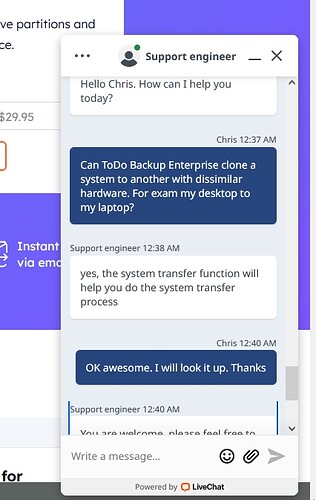Hello, as usual, I am asking this here because the Directory Opus users are super knowledgeable about concepts in computing. I use desktops and laptops for my work. I always have the problem where my work environment on my desktop is not exactly the same as my laptop. I do my work 80% of the time on my desktop.
A while ago, I could use imaging software (Acronis) and clone my OS to my laptop, which worked perfectly. Mind you that it only worked for the OS and programs (Adobe, Microsoft, FileMaker, Directory Opus, etc.) setting and environment. My data (D drive, etc.) still had the problem of not being an exact copy. However, this stopped working when I tried it on newer systems.
To be clear, I am looking for a way to have the same working system on my laptop as my desktop. I need to also have the current files from external drives (other than C) always in sync. I do know the syncing part Opus does robustly. I just have no experience with it. I realize I am asking a lot. However, I want to be pointed in the correct direction if there is no easy answer. No suggestion is out of place. Thanks for any help.
I use Dropbox for everything that fits in there and Syncthing for everything that does not (mostly media files).
For the working files it can also be an option to use a cloud service or a NAS (so you do not have to store everything twice).
I'd be weary of imaging a desktop to a laptop, since laptops sometimes have quite specific drivers for their hardware. Although generic drivers (or whatever Windows Update finds) might be "good enough" in a lot of cases these days, you might run into issues (especially with sleep/hibernate), or worse performance (especially on the GPU side).
Is there a way to do this properly? I mean, clone a PC's full OS with programs to another computer with the correct drivers. I have seen something that uses virtual machines to do something like this.
I don't know if there's a good way, with Windows, which won't hurt performance or get in the way.
And how would you sync data and apps back in the other direction? I'm not sure the approach of imaging the entire machine really makes sense, except as a one-off.
As a one-off, simply installing the software manually is a lot easier than trying to clone a machine. If you keep your installers, reinstalling software or installing when you first need it is fairly quick, in my experience. (With the exception of those annoying "web installers" that make you download everything every time.) And if you're reinstalling the whole OS and software often, something else is probably the problem. (Automated/silent installs could be the solution there, but I'd first ask why you need to do it at all, more than once every 5 years or so.)
For synching data, the cloud storage options people mentioned are likely the best way to go.
You could also set up roaming profiles in Windows, which will sync application settings as well as data, but those are a pain to set up and work with (unless you're in an enterprise environment where someone does it for you) and they don't behave the way most people expect, especially with devices which are sometimes offline or where you're logged into two devices at once.
Thanks for the reply. I see, and I am glad to learn about Syncthing.
I am thinking about using a NAS. Thanks
I remember back to the time when I used to rely on Acronis to make PC images. Acronis talked about a concept called Universal Restore. Universal Restore was restoring a PC image to a machine with dissimilar hardware. Since that time, I do not use Acronis. I now use EaseUS ToDo Backup. Their explanation was this:
I had this same problem. I learned that I can only commit to one computer at a time. My solution was a really nice laptop with a dock at my desk. I replaced my desktop with an Unraid server that runs a Windows VM that I can access over an RDP session for more intensive tasks. The advantage is I can have my desktop anywhere I go since I have a Wireguard tunnel set up as well. For me, having what is essentially a headless, virtualized desktop PC works really well.
Yes, I have seen that Virtual Systems can have a way to do this. I think when I explained my question, it seemed like my goal was only duplicating my system to be like a desktop. I also am interested in making PC images that cut down on the redundant installation of software. The point being, I know that Virtualization can help with that. Thank you for your response.
You can run Windows on a hypervisor like ESXi or Proxmox, set up your programs and settings and then take a snapshot so you can easily redeploy your system back to stock. Pass through a GPU and USB controller to use at a desk and then when on the go access it over an RDP session.
